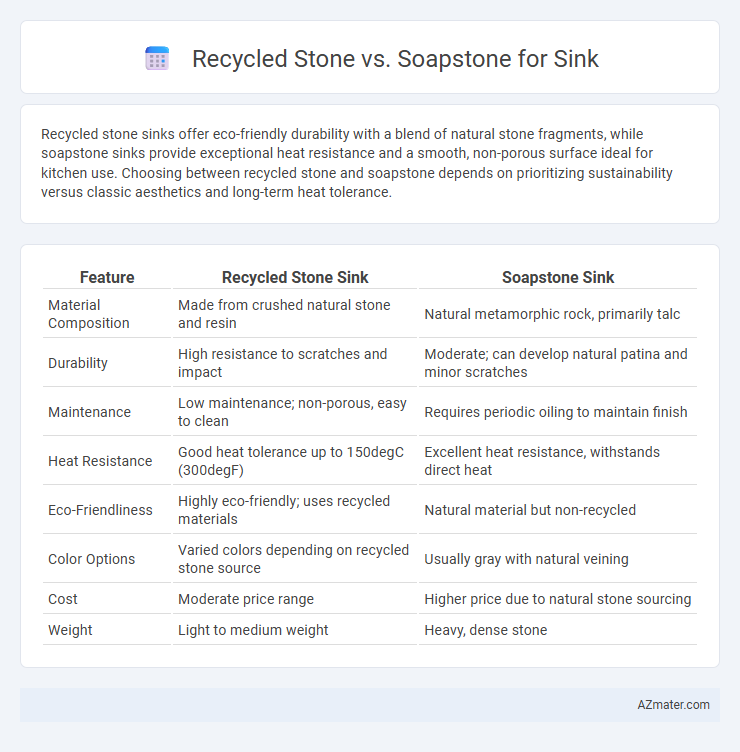Recycled stone sinks offer eco-friendly durability with a blend of natural stone fragments, while soapstone sinks provide exceptional heat resistance and a smooth, non-porous surface ideal for kitchen use. Choosing between recycled stone and soapstone depends on prioritizing sustainability versus classic aesthetics and long-term heat tolerance.
Table of Comparison
| Feature | Recycled Stone Sink | Soapstone Sink |
|---|---|---|
| Material Composition | Made from crushed natural stone and resin | Natural metamorphic rock, primarily talc |
| Durability | High resistance to scratches and impact | Moderate; can develop natural patina and minor scratches |
| Maintenance | Low maintenance; non-porous, easy to clean | Requires periodic oiling to maintain finish |
| Heat Resistance | Good heat tolerance up to 150degC (300degF) | Excellent heat resistance, withstands direct heat |
| Eco-Friendliness | Highly eco-friendly; uses recycled materials | Natural material but non-recycled |
| Color Options | Varied colors depending on recycled stone source | Usually gray with natural veining |
| Cost | Moderate price range | Higher price due to natural stone sourcing |
| Weight | Light to medium weight | Heavy, dense stone |
Introduction to Recycled Stone and Soapstone Sinks
Recycled stone sinks are made from crushed natural stone pieces bound together with resin, offering a sustainable and eco-friendly alternative for kitchen and bathroom fixtures. Soapstone sinks, crafted from dense, non-porous metamorphic rock composed primarily of talc, provide exceptional durability and resistance to stains and heat. Both materials present unique aesthetic and practical benefits, with recycled stone emphasizing environmental impact and soapstone highlighting long-lasting performance and classic appearance.
Sustainability and Eco-Friendliness Comparison
Recycled stone sinks utilize reclaimed materials, significantly reducing landfill waste and conserving natural resources, making them an eco-friendly choice with lower carbon footprints. Soapstone, a natural metamorphic rock known for durability and chemical resistance, is quarried sustainably but involves resource extraction impacting ecosystems. Both materials offer sustainable options; recycled stone emphasizes circular economy benefits, while soapstone provides longevity and natural resistance, contributing to reduced replacement frequency and waste.
Material Composition and Origins
Recycled stone sinks are crafted from crushed natural stone fragments bonded with resins or cement, offering an eco-friendly option by repurposing waste materials. Soapstone sinks originate from metamorphic rock primarily composed of talc, prized for its heat resistance and smooth, non-porous surface. The sustainable appeal of recycled stone contrasts with the natural durability and unique veining of soapstone, each reflecting different geological origins and material properties.
Durability and Longevity Differences
Recycled stone sinks offer strong durability due to their composite nature, combining crushed stone with resin, which makes them resistant to impact and chipping, though they may be more prone to discoloration over time compared to natural materials. Soapstone sinks boast exceptional longevity, resistant to heat, stains, and acids, and develop a unique patina with use, enhancing their aesthetic appeal while maintaining structural integrity for decades. The choice between recycled stone and soapstone hinges on the balance between eco-friendly material resilience and the classic, enduring durability inherent in natural soapstone.
Design Aesthetics and Customization Options
Recycled stone sinks offer a unique, eco-friendly aesthetic with natural variations in color and texture that add character to contemporary and rustic kitchens. Soapstone sinks feature a smooth, matte finish with rich, deep hues of gray and green, providing a timeless, elegant look that darkens and enhances with age. Both materials allow custom sizing and shapes, but soapstone's softer nature enables more intricate edge profiles and integrated drainboards for tailored design options.
Maintenance and Cleaning Requirements
Recycled stone sinks require gentle cleaning with non-abrasive, pH-neutral cleaners to prevent surface damage and maintain their polished finish, while soapstone sinks demand regular oiling to enhance their natural patina and resist stains. Both materials are highly durable and resistant to heat, but soapstone's non-porous surface offers superior resistance to bacteria and requires less frequent sealing compared to recycled stone. Proper maintenance extends the lifespan of each sink type, with soapstone being easier to clean but recycled stone offering greater variety in design options.
Resistance to Stains, Scratches, and Heat
Recycled stone sinks offer excellent resistance to heat and scratches due to their composite makeup of crushed stone bound with resin, making them durable for kitchen use. Soapstone sinks are naturally dense and non-porous, providing superior resistance to stains and heat, though they may be more prone to scratching compared to recycled stone. Both materials require regular maintenance to preserve their appearance, but soapstone's ability to develop a patina over time can help conceal minor scratches.
Cost Analysis: Recycled Stone vs Soapstone
Recycled stone sinks offer a cost-effective alternative, typically priced 20-40% lower than soapstone, making them accessible for budget-conscious renovations. Soapstone sinks command higher prices due to their natural durability, resistance to heat and stains, and unique aesthetic appeal, often ranging from $400 to $900. Long-term maintenance costs also differ, as soapstone requires periodic oiling to maintain its finish, whereas recycled stone demands minimal upkeep, reducing overall lifetime expenses.
Installation Considerations for Both Materials
Recycled stone sinks require careful handling due to their composite nature, often demanding professional installation to ensure proper sealing and to avoid cracking under stress. Soapstone sinks are generally softer and heavier, necessitating sturdy cabinetry and precise cutouts to accommodate their weight and prevent damage during installation. Both materials benefit from pre-drilled drains and sealing treatments to maintain durability and water resistance over time.
Final Verdict: Choosing the Right Sink Material
Recycled stone offers exceptional sustainability with robust durability and a unique aesthetic from repurposed materials, making it an eco-friendly choice for sinks. Soapstone provides natural resistance to stains and heat, along with a smooth, non-porous surface that requires minimal maintenance. Selecting the right sink material depends on prioritizing environmental impact and durability versus timeless appearance and ease of care.

Infographic: Recycled stone vs Soapstone for Sink
 azmater.com
azmater.com